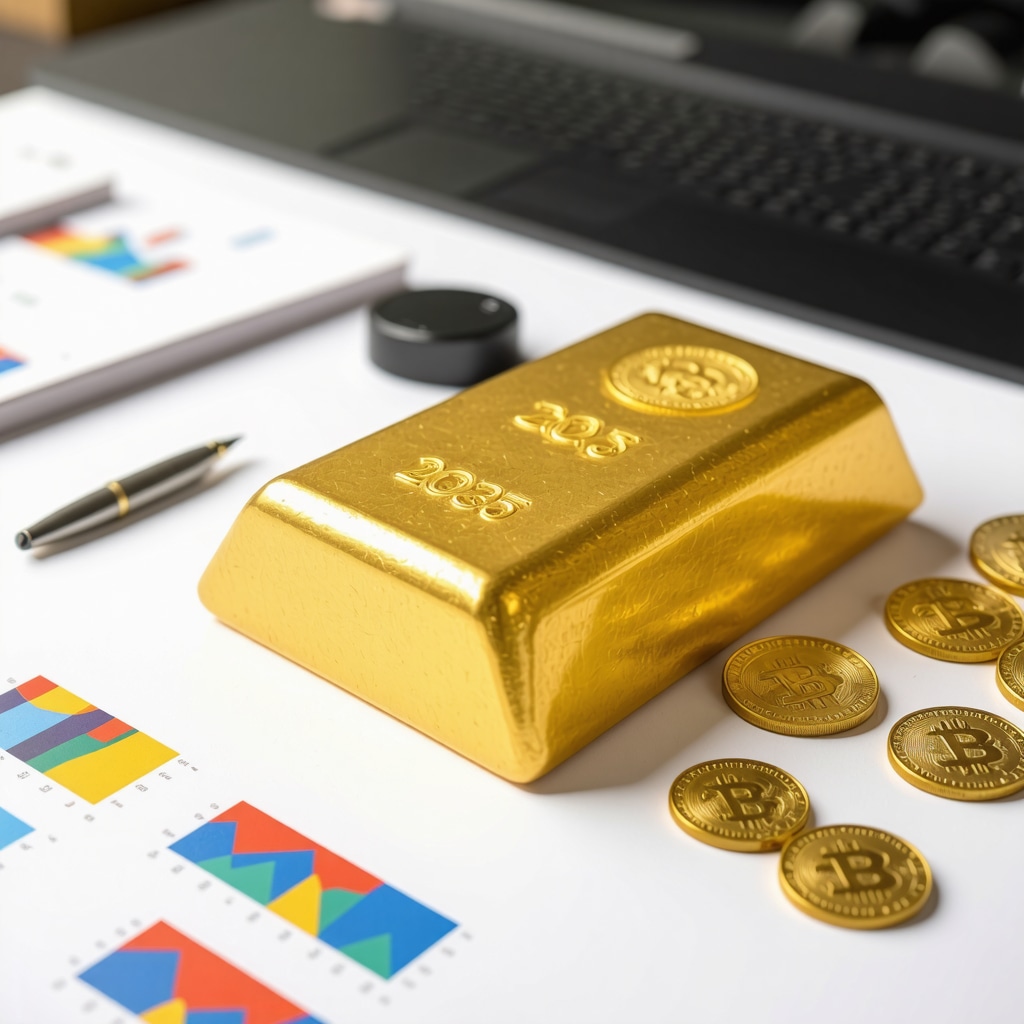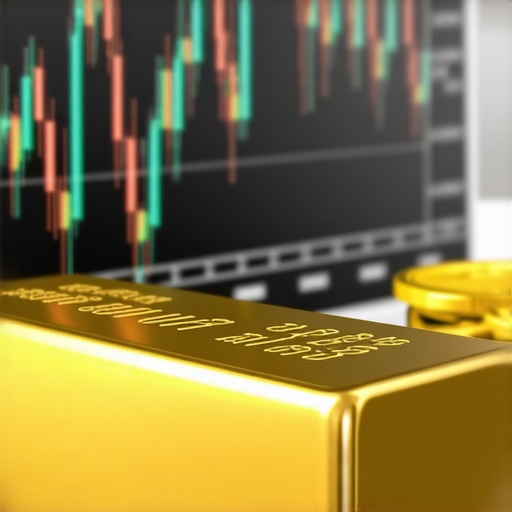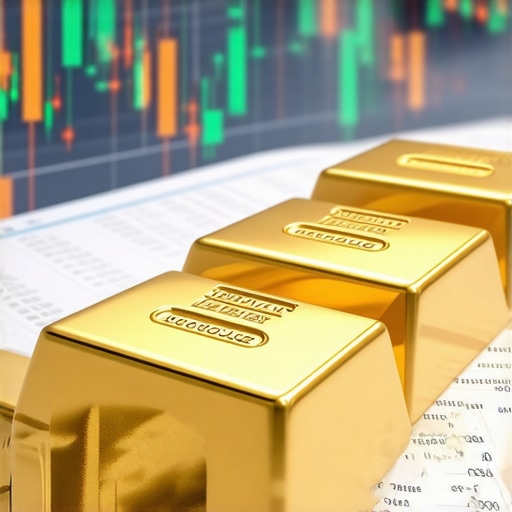Unlocking the Timeless Value of Gold: Why 2025 Demands Strategic Long-Term Investment
In a world marked by economic uncertainty and fluctuating markets, gold remains an enduring beacon of wealth preservation. As we approach 2025, understanding long-term gold investment strategies is essential for investors who seek to safeguard their portfolios against inflation, currency devaluation, and geopolitical volatility. This article delves into nuanced methods that go beyond basic buying and holding, offering expert perspectives that illuminate how to optimize gold’s wealth-preserving potential.
Crafting Your Gold Portfolio: The Art of Diversification Within Precious Metals
While gold itself is a singular asset, strategic diversification within its forms can significantly enhance your investment’s resilience. Combining physical gold (such as coins and bars) with gold-backed financial instruments like ETFs and mutual funds can balance liquidity and security. For example, physical gold offers tangible asset protection but requires secure storage, whereas ETFs provide ease of trading and portfolio flexibility.
Integrating various investment vehicles allows investors to adjust exposure based on market conditions and personal risk tolerance. For in-depth guidance on choosing between these options, explore insights on physical gold vs ETFs to tailor a strategy that fits your long-term goals.
How Do Macroeconomic Trends Shape Gold Investment Strategies in 2025?
Gold’s performance is intricately linked to global economic indicators such as inflation rates, currency strength, and geopolitical tensions. In 2025, persistent inflationary pressures and potential central bank policy shifts are expected to influence gold prices. Investors must monitor these macroeconomic signals closely to time their entries and exits effectively.
Moreover, emerging market demand, particularly from nations with growing middle classes, continues to exert upward pressure on gold prices. Understanding these dynamics enables investors to anticipate price movements and adjust their holdings accordingly. Authoritative analysis from the World Gold Council offers invaluable data and forecasts that can refine your strategic approach.
Embracing Gold IRAs: A Retirement Strategy Anchored in Stability
For long-term investors aiming to preserve wealth beyond conventional portfolios, gold Individual Retirement Accounts (IRAs) present a compelling option. These accounts combine the tax advantages of retirement planning with the intrinsic value of gold, offering a powerful hedge against market volatility.
Setting up a gold IRA requires careful selection of custodians and understanding regulatory nuances. For a detailed roadmap on initiating this retirement strategy, consider reviewing the comprehensive best gold IRA investment strategies that align with long-term financial goals.
Physical Gold Acquisition: Safety, Authenticity, and Storage Considerations
Investing in physical gold involves critical decisions regarding purchase sources and storage methods. Trusted dealers with transparent pricing and verifiable authenticity certificates are paramount to avoid counterfeit risks. Additionally, secure storage solutions ranging from home safes to professional vaults are vital to protect this valuable asset.
For investors new to physical gold, a step-by-step guide on how to buy gold safely from trusted dealers can reduce risks and enhance confidence in your acquisitions.
Integrating Gold Into a Holistic Wealth Preservation Strategy
Gold should not be viewed in isolation but as part of a broader, diversified investment approach tailored to your financial horizon and risk appetite. Balancing gold with equities, bonds, and alternative assets can optimize portfolio returns while cushioning against systemic shocks.
By combining expert insights on gold market trends, diversified investment vehicles, and practical acquisition strategies, investors can construct a robust framework designed to preserve and grow wealth throughout 2025 and beyond.
If you’ve found these insights valuable, consider sharing this article with fellow investors or leaving a comment to discuss your gold investment experiences and strategies.
Learning from Experience: My Journey with Physical Gold Storage
When I first decided to diversify my portfolio with physical gold, the question of storage quickly became a major concern. I initially considered a home safe, thinking it would offer convenience and control. However, after a few months, the reality of potential theft risks and insurance complexities nudged me to explore professional vault storage. The peace of mind knowing my gold was securely stored off-site was invaluable, especially during uncertain times.
For those new to physical gold investing, I recommend investigating various storage options carefully. Whether you opt for a home safe or a professional vault, understanding the trade-offs between accessibility, security, and cost is essential. Resources like the quick tips for safe gold bullion storage provide practical advice that helped me make informed decisions.
When Is the Right Time to Buy Gold? Timing and Market Sentiments
I often get asked, “Is there a perfect moment to buy gold?” From my experience, timing the market precisely is challenging, even for seasoned investors. Instead, I’ve found that consistent, periodic purchases—often called dollar-cost averaging—can reduce the impact of price volatility over time.
Watching market sentiment and macroeconomic indicators can inform better timing. For example, during periods of rising inflation or geopolitical instability, gold prices tend to rally. Keeping an eye on key gold price forecasts for 2025 has helped me anticipate such shifts and adjust my buying strategy accordingly.
Have you ever wondered how global events directly affect your gold investments?
Global events, from central bank policies to supply chain disruptions, can create ripples in gold prices. For instance, when major economies signal interest rate hikes, gold often reacts due to its inverse relationship with real yields. Personally, tracking news through trusted analysis like that from the World Gold Council has been instrumental in navigating these fluctuations.
One memorable instance was during a sudden geopolitical crisis when I noticed a swift uptick in gold demand and prices. Understanding these connections deepened my appreciation for gold as a dynamic asset rather than just a static store of value.
The Role of Gold Mining Stocks in Diversifying Your Precious Metals Portfolio
Beyond physical gold and ETFs, gold mining stocks offer an intriguing layer of diversification. Initially, I was hesitant due to their exposure to operational risks and market volatility. However, after researching and investing selectively, I realized these stocks could amplify returns when gold prices rise.
That said, it’s crucial to analyze these companies carefully, considering factors like production costs, geopolitical risks in mining regions, and management quality. For those interested, a detailed exploration on how to analyze gold mining stocks provides valuable frameworks.
In my journey, balancing physical gold with mining stocks and ETFs has created a more resilient portfolio that adapts well to changing market conditions.
Do you have any personal experiences with gold investments you’d like to share? Feel free to comment below or join the conversation by sharing this article with fellow investors!
Harnessing Algorithmic Trading and AI Insights to Optimize Gold Investment Timing
In the digital age, leveraging technology to enhance gold investment strategies has become not only feasible but essential for sophisticated investors. Algorithmic trading platforms and AI-powered analytics tools provide real-time market data processing, enabling investors to identify subtle patterns and price anomalies that traditional analysis might overlook.
By integrating machine learning models trained on historical gold price movements alongside macroeconomic indicators such as inflation trends and currency fluctuations, investors can refine entry and exit points with greater precision. This approach transcends simple trend following, offering predictive insights that adapt dynamically to unfolding global events.
Can AI and Algorithmic Models Truly Mitigate the Volatility of Gold Prices?
While no model guarantees absolute foresight, advanced AI systems significantly enhance risk management by simulating myriad scenarios and stress-testing portfolios against complex variables. For example, these systems can incorporate geopolitical event probabilities, central bank policy shifts, and commodity market interdependencies to forecast potential price impacts.
Research published by the Nature Scientific Reports highlights how machine learning algorithms outperform traditional linear models in predicting gold price fluctuations with higher accuracy, especially during periods of market stress. This evidence underscores the transformative potential of AI in precious metals investing.
Exploring Blockchain-Enabled Gold Investment Platforms: Transparency and Liquidity Redefined
Blockchain technology is revolutionizing gold ownership and trading by tokenizing physical gold assets into digital tokens. These tokens represent verifiable ownership stakes backed by allocated physical gold, combining the asset’s intrinsic value with enhanced liquidity and transparency.
Such platforms allow investors to buy, sell, and transfer gold tokens swiftly without the traditional constraints of physical custody or excessive transaction costs. Moreover, blockchain’s immutable ledger ensures provenance and authenticity, mitigating risks associated with counterfeit or improperly sourced gold.
However, investors must conduct due diligence regarding the custodianship of the underlying physical gold and regulatory compliance of the token issuers. Understanding the technical architecture and legal frameworks of these platforms is critical to harnessing their full benefits securely.
Advanced Risk Management: Hedging Gold Exposure with Derivatives and Options
Seasoned investors often employ derivatives such as futures and options to hedge gold exposure, manage portfolio volatility, and capitalize on price movements without the need to hold physical assets. Mastery of these instruments demands comprehensive knowledge of contract specifications, margin requirements, and expiration cycles.
For instance, purchasing gold put options can provide downside protection during anticipated market downturns, while call options may serve as leveraged exposure during bullish phases. Strategic combinations of these derivatives, known as spreads, enable nuanced positioning tailored to specific risk appetites and market outlooks.
Engaging with derivatives markets requires not only technical expertise but also disciplined risk controls to avoid over-leverage and unexpected losses. Investors should consider educational resources and professional advisory services to navigate this complex landscape effectively.
What Are the Critical Considerations When Integrating Gold Derivatives into a Long-Term Portfolio?
Integrating gold derivatives should align with overarching investment objectives and risk tolerance. Key considerations include liquidity of the contracts, counterparty risks, tax implications, and the potential impact on portfolio diversification. Moreover, understanding the interplay between physical gold holdings and derivative positions is essential to avoid unintended exposure.
Expert consultation and continuous portfolio monitoring are vital to adjust derivative strategies in response to evolving market conditions and personal financial goals.
Embracing Environmental, Social, and Governance (ESG) Criteria in Gold Investments
With growing investor demand for responsible investing, ESG considerations are increasingly influencing gold investment decisions. Ethical sourcing, environmental impact of mining operations, and corporate governance standards are now integral to assessing gold-related assets.
Investors should evaluate gold mining companies and funds based on transparency in their ESG disclosures, efforts to reduce carbon footprints, community engagement, and adherence to international standards such as the Responsible Gold Mining Principles (RGMP). Choosing ESG-compliant investments not only aligns with personal values but can also mitigate long-term operational risks and enhance reputational stability.
For a comprehensive overview of ESG integration in gold investments, consulting resources from the Responsible Mining Initiative provides authoritative guidance.
Are you ready to elevate your gold investment strategy with cutting-edge tools and ethical considerations? Dive deeper into these advanced concepts and join our expert community by sharing your experiences and questions below.
Decoding the Intersection of Quantitative Finance and Gold Market Dynamics
As financial markets grow increasingly complex, integrating quantitative finance methods into gold investment strategies offers a frontier for enhanced returns and risk mitigation. Sophisticated models that incorporate stochastic calculus, volatility clustering, and regime-switching processes enable investors to capture nuanced price behaviors of gold beyond traditional indicators.
This quantitative rigor facilitates constructing optimized portfolios that balance expected return and risk exposure while adapting dynamically to shifting macroeconomic regimes. For practitioners seeking to deepen their expertise, the Journal of Finance provides peer-reviewed analyses illustrating advanced applications of quantitative models in commodities investing.
Tokenization of Gold: Navigating Regulatory and Security Challenges for Institutional Investors
While blockchain-enabled gold tokens promise unparalleled liquidity and fractional ownership, institutional investors must remain vigilant about evolving regulatory frameworks and cybersecurity risks. Jurisdictional discrepancies in recognizing digital asset securities necessitate comprehensive compliance strategies that align with Anti-Money Laundering (AML) and Know Your Customer (KYC) protocols.
Additionally, safeguarding private keys and smart contract audit integrity are critical to mitigating vulnerabilities intrinsic to decentralized platforms. Engaging with vetted custodians and leveraging multi-signature wallets can enhance security postures for institutional-grade gold token portfolios.
How Can Institutional Investors Effectively Integrate Blockchain-Based Gold Assets While Managing Regulatory Compliance?
Institutional adoption hinges on harmonizing technological innovation with stringent regulatory adherence. Developing robust governance frameworks that encompass due diligence, legal reviews, and continuous monitoring is vital. Collaborative efforts between industry consortia and regulators are fostering clearer guidelines, facilitating safer market entry.
Insights from the International Organization of Securities Commissions (IOSCO) offer authoritative perspectives on best practices for integrating digital asset investments within institutional mandates, emphasizing transparency and investor protection.
Synergizing ESG Mandates and Technological Innovation in Gold Mining Investments
Beyond screening for responsible mining practices, integrating cutting-edge technologies like satellite monitoring, IoT sensors, and AI-driven environmental analytics enables real-time ESG performance tracking. This proactive approach allows investors to assess operational impacts continuously and engage with mining companies on sustainability initiatives effectively.
Such integration not only mitigates reputational risks but also identifies opportunities where technological adoption drives cost efficiencies and environmental stewardship, aligning financial returns with ethical imperatives.
Invitation to Engage: Elevate Your Gold Investment Strategy with Advanced Insights
Embracing these multifaceted strategies—from quantitative finance to blockchain innovation and ESG technology integration—empowers investors to navigate the gold market’s evolving landscape with sophistication and agility. Join our expert forum to share your experiences, discuss emerging trends, and access exclusive resources designed to refine your approach and maximize your investment outcomes.
Frequently Asked Questions (FAQ)
What are the key advantages of investing in gold for the long term?
Gold serves as a proven hedge against inflation and currency devaluation, providing portfolio diversification and wealth preservation during economic uncertainty. Its intrinsic value and global demand make it a stable asset that can mitigate risks associated with equities and bonds over extended periods.
How should I choose between physical gold, ETFs, and gold mining stocks?
Each investment vehicle offers distinct benefits and risks. Physical gold provides tangible asset security but requires safe storage; ETFs offer liquidity and ease of trading; mining stocks can deliver leveraged exposure but entail operational risks. A balanced portfolio tailored to your risk tolerance and investment horizon often combines these elements.
Can algorithmic trading and AI improve timing in gold investments?
Yes, advanced AI models and algorithmic trading utilize vast datasets and predictive analytics to identify price patterns and market signals beyond traditional methods. While they cannot guarantee perfect timing, these tools enhance risk management and enable more informed entry and exit decisions.
What considerations should I keep in mind when using gold derivatives?
Investors must understand contract terms, margin requirements, tax implications, and potential counterparty risks. Derivatives can hedge downside exposure or provide leveraged investment but require disciplined risk controls to avoid over-leverage and unexpected losses.
How do ESG factors influence gold investments today?
Environmental, Social, and Governance (ESG) criteria are increasingly critical. Ethical sourcing, environmental impact mitigation, and good corporate governance reduce operational risks and align investments with sustainability values. Evaluating ESG disclosures and compliance with standards like the Responsible Gold Mining Principles is essential.
What are the benefits and risks of blockchain-enabled gold tokenization?
Tokenization enhances liquidity and transparency by converting physical gold into digital tokens with verified provenance. However, investors should assess regulatory compliance, custodianship integrity, cybersecurity risks, and legal frameworks to ensure secure and compliant participation.
Is a gold IRA a good option for retirement planning?
Gold IRAs combine tax advantages with gold’s wealth preservation qualities, offering diversification beyond traditional retirement assets. Proper custodian selection and regulatory understanding are crucial to maximize benefits and ensure compliance.
How do global macroeconomic events impact gold prices?
Gold prices react strongly to inflation rates, currency fluctuations, central bank policies, and geopolitical tensions. Monitoring these macroeconomic indicators enables investors to anticipate price movements and adjust holdings strategically.
What storage options are recommended for physical gold?
Safe storage is vital. Options include insured home safes for convenience or professional vaults for enhanced security and risk mitigation. Evaluating accessibility, insurance coverage, and cost will guide the optimal choice.
How can institutional investors integrate blockchain-based gold assets while managing regulatory compliance?
Institutions should develop robust governance frameworks encompassing legal reviews, due diligence, continuous monitoring, and compliance with AML/KYC protocols. Collaboration with regulators and adherence to industry best practices ensure secure and compliant asset integration.
Trusted External Sources
- World Gold Council – Offers comprehensive market insights, data analytics, and forecasts essential for understanding gold demand-supply dynamics and investment trends globally.
- Nature Scientific Reports – Publishes peer-reviewed research on machine learning applications in gold price forecasting, providing evidence-based insights into algorithmic trading efficacy.
- Responsible Mining Initiative – Provides authoritative guidelines and standards for ESG compliance in gold mining, crucial for investors prioritizing ethical and sustainable investments.
- Journal of Finance – Features advanced quantitative finance research, including sophisticated modeling techniques applicable to commodities and gold market dynamics.
- International Organization of Securities Commissions (IOSCO) – Offers regulatory frameworks and best practices for digital asset investments, vital for institutional investors navigating blockchain-based gold assets.
Conclusion
Long-term gold investment in 2025 demands a multifaceted approach that blends traditional wisdom with cutting-edge innovation. By diversifying across physical gold, ETFs, mining stocks, and derivatives, investors can optimize portfolio resilience. Incorporating advanced technologies such as AI-driven analytics and blockchain tokenization enhances market insight and liquidity, while ESG integration ensures alignment with evolving ethical standards. Vigilance toward macroeconomic trends and regulatory landscapes further sharpens strategic decision-making.
Ultimately, mastering these complex yet rewarding strategies empowers investors to safeguard and grow wealth amid volatile global markets. We invite you to apply these insights, engage with our expert community, and explore further expert content to elevate your gold investment journey.
Share this article with fellow investors, leave your comments, and join the conversation to deepen your mastery of long-term gold investment strategies.










